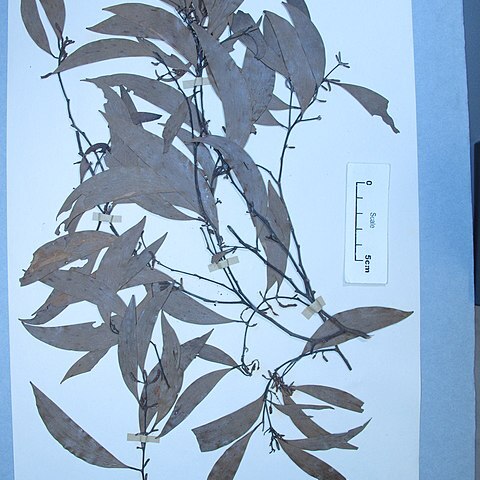Tree to 33 m high, bole to 18 m high, d.b.h. up to 35 cm. Branchlets angular, scurfy. Phyllodes falcate, 11-20 by 1-4.5 cm, 272-12 times as long as wide, gradually narrowing into the pulvinus, grey, silvergreen, or glaucous green, usually with a yellow margin when dry; pulvinus (4-)5-20 mm; one gland at top of pulvinus, circular in outline, with an orifice, c. 1 mm in diameter; primary longitudinal veins 3-5, yellowish, close to the basiscopic margin at base, secondary veins ± parallel, not anastomosing. Spikes moderately dense, 4.5-6 by 0.5 cm, on scurfy peduncles 5-10 mm, 2 to 6 together in the upper phyllode axils. Flowers yellow, pentamerous. Calyx broadly cupular, 0.5-0.7 mm, membranous, with scurfy, concave lobes, lobed to about halfway down. Corolla widely spreading, glabrous, 1.3-1.6 mm. Stamens 2-3 mm. Ovary shortly puberulous. Pod dark brown, with a whitish bloom when young, obovoid-oblong, flat, up to 5 by 2-3.5 cm, valves woody, transversely veined but hardly reticulate, glabrous. Seeds transverse, in separate compartments, oblong, 5-6 by 2-3 mm; areole large, constricted towards the base, almost closed; funicle thickened folded, forming a long aril below the seed.
An evergreen tree. It grows to a height of 8-14 m with a spread of 4-8 m. It grows larger under more favourable conditions. The stems are erect and smooth. The leaves (phyllodes) are curved or sickle shaped and leathery. They are 10-24 cm long and taper towards both ends. They have prominent veins. They are covered with a powdery bloom. The flowers are golden rods. They are 4-6 cm long The flowers are in pairs. The pods are long (5-7 cm) and brown. They are 1.5 to 3.5 cm thick. They are hard and woody. The seeds are dark brown.


